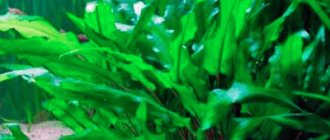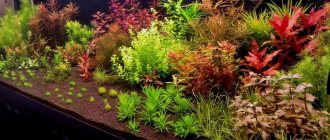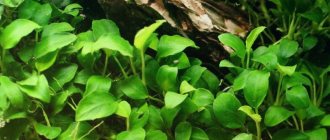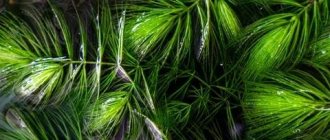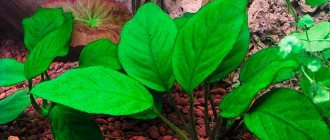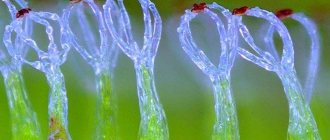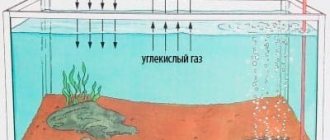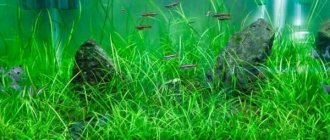Conditions in the aquarium
Grows well in a moderately warm aquarium at a temperature of 18-22 degrees, as well as in a tropical aquarium at temperatures above 24 degrees. As for water, it is desirable that its hardness does not fall below 8 degrees, and the pH reaction is 5.5 - 6.8. You can train it to a higher rigidity, but in this case the plant will grow slowly and the leaves will become small.
For cabomba to look beautiful, the aquarium must have clean water. If a fine suspension floats in the water, then the leaves of the plant will collect it and turn brownish, and then begin to fall off altogether. Be sure to change the water once a week.
For full growth, cabomba requires strong lighting of 50-70 lm/l. With a lack of light, the color of the leaves will become faded, and the plant itself will begin to stretch upward. The duration of daylight hours is 10-12 hours.
The root system of cabomba is delicate and well developed. Therefore, soil with a fraction of 2-4 mm and a soil thickness of 5-6 cm is suitable as a substrate. In coarser soil, roots will develop poorly. When planting in silty soil, do not put any fertilizer under the roots. If the soil is new, then place clay or special root tablets under the roots of the plant.
Origin and description
Cabomba furcata is native to Central and South America. It grows in a dense carpet from red to purple. Prefers soft, acidic bodies of water with calm currents.
Cabomba furcata has pinnate, forked leaves divided into narrow segments that are green to dark red in color. Cabomba furcata contrasts well with other plants and driftwood, forms dense thickets, creating an excellent, natural background in the aquarium.
Under optimal conditions, the tops of the reddish cabomba can easily reach the surface of the average aquarium within a week or so. However, if there is insufficient lighting, the plant's growth will slow down. If the plant reaches the surface of the water, the cabomba may begin to send out side shoots. In an aquarium it grows to a height of 30-90 cm, so it needs regular trimming.
Cabomba aquatica
It grows in slow-flowing waters of South America, Brazil and Guiana. The root of cabomba vulgare is creeping. Young plants emerge from nodes formed on the root. While the plant is small, it reaches for the light, but as it grows, it sinks to the bottom under the weight of its weight. The leaves are fan-shaped and dissected. Their color can, depending on the conditions of detention, vary from dark green to slightly reddish.
Cabomba with reddish leaves is a demanding plant. For its growth it requires strong lighting and weekly water changes. The water temperature should be 23-25 degrees, hardness dH 4-10°, acidity pH 6.5-7.0. In good conditions it grows up to 1-1.5 m in length. It blooms from April to June with small white flowers with a yellow center.
Cabomba in nature
The red algae cabomba grows in lakes and swampy rivers with a slow current at a depth of up to 1.5 m and belongs to the nymphaeaceae family. Breeders have developed an independent species called cabomba.
Classification:
- Caroline.
- Red.
- The most beautiful.
- Water.
- Spiral-leaved.
The plant came to Europe in 1906 and is still popular among aquarists.
External features:
- The stem is long, thin, grows vertically, does not send out branches, and spreads on the surface.
- Petals grow opposite or 3 per whorl. The upper leaves float, are not separated, are placed alternately, each has a petiole.
- The root system is thin and weak.
- The inflorescences are solitary, located in the axils of the upper leaves.
In shallow warm waters of South America it spreads over the entire bottom, creating a natural multi-colored decoration.
Cabomba caroliniana, Cabomba australis
Cabomba carolina is a popular unpretentious plant with a straight and tall stem. Upon reaching the surface of the water, it begins to creep along it. Blooms only in good conditions. At the same time, small shoots with small yellow flowers emerge from the upper whorls of leaves, which bloom above the surface of the water. After transplantation, it takes a long time to adapt, so choose a place in the aquarium for the plant right away. The leaves of the plant are small, fan-shaped. They are bright green above and light green below. Comfortable conditions: water temperature 24-30°C, hardness dH 2-6°, acidity pH 6.0-7.0, lighting of at least 60 lm/l for 10-12 hours.
Cabomba in an aquarium
A container of any size is suitable, the cuttings are planted in the sand in the center, in the corners, under the back wall, it goes well with Canadian elodea.
Functions:
- A good shelter for young animals.
- Spawning site for females.
- Cabomba in an aquarium is involved in metabolism, absorbs harmful toxins, filters, and attracts lime fragments.
Large animals destroy the structure of the stems and tear off the petals; small fish are suitable for large thickets.
The most beautiful cabomba (Cabomba caroliniana var. pulcherrima)
The most beautiful cabomba is a capricious plant, rarely found in the aquariums of aquarists. The stem of the plant is long and straight. On it, under water, opposite each other, there are palmately dissected leaves about 8 cm wide. The floating leaves of the plant are whole, about 3-4 cm long, arranged alternately. At their nodes one purple flower is formed. The color of the leaves on top, depending on the conditions, can vary from brownish-green to red, and on the bottom the leaves are red.
The plant should be kept at a temperature of 22-28 degrees, hardness dH 2-4°, acidity pH 6.0-7.0. Every week it is necessary to replace 1/3 of the water with fresh water. The lighting should be bright, at least 60 lm/l. Daylight hours are 11-12 hours. In low light, the castings take on a pale green color and the stem becomes elongated. Doesn't like transplants.
Pests and diseases
If, when planting, you buried the stem of the plant too much, the cabomba may rot. To root, simply press the stem to the bottom with a pebble.
Blue-green algae that grows in hard water is harmful to cabomba. Try to maintain this indicator at a level that is safe for the plant and promptly remove harmful algae from the water.
- Golden mustache: description of cultivation, properties
Among the pests, snails pose a danger to cabomba. Simply remove the shellfish from the aquarium.
The most important condition for the health of cabomba is clean, silted-free water. If you find that the leaves of the plant have changed color and began to wither, break and fall off, immediately clean the aquarium of sediment and silt and change the water.
Cabomba furcata (Cabomba piauhyensis) or reddish (Cabomba furcata)
It grows in stagnant bodies of water in northern South America and the Greater Antilles.
The height of an adult plant is 40 cm. Having reached the surface of the water, the stem begins to spread along it, and floating leaves appear on it. The stem itself is long and quite elastic, with almost no branches. Underwater, the leaves are arranged oppositely. The underwater leaf has a rounded shape, its plate is palmately dissected up to 4 cm wide. The top of the leaflets located under water has a color from olive green to slightly reddish, and the bottom of the leaf is red. The length of the floating leaves is about 3 cm. Their shape is lanceolate. The petals of the corolla are purple at each edge, and a yellow spot is noticeable at the base.
In order for the plant to grow quickly (about 10 cm per month), it needs to create comfortable conditions. The water temperature should be within 24-28 degrees, pH 6.0-6.8, hardness no higher than 8°. The lighting in the aquarium should be quite bright 70 lm/l. The lamps are turned on for 12 hours. Reddish cabomba is planted in groups in the background in coarse sand.
Cabomba red, reddish or forked
Red cabomba photo
Cabomba piauhyensis is one of the most beautiful cabombas. A plant with an elongated erect stem. The leaf arrangement is opposite or whorled. The leaf blade is red-yellow, up to 5 cm wide. The petals of the corolla are purple, with a yellow spot at the base on each edge. Plant height up to 40 cm.
Typically, the plant is planted in a group in the middle and background of the aquarium. There should be at least 12 hours of daylight. Direct sunlight is not recommended. Comfortable water parameters for keeping: water 24-27° C, KH 2-8°, pH 6-6.8; lighting 0.7-1+ W/l. The plant propagates by cuttings.
Cabomba forked photo
If the environmental conditions fully satisfy the requirements of kabomba, then it grows quickly, growing by an average of 10 cm per month. The plant looks very beautiful when planted in small groups in the background or on the sides of the aquarium. It is very important to immediately decide on the location of the future planting of the plant, because it does not tolerate transplants well.
Red cabomba requires more careful attention from the aquarist. It is desirable to have at least a small supply of carbon dioxide and the application of macro and micro fertilizers, especially iron Fe. If well maintained, the forked cabomba will flare up with a crimson flame =)
Cabomba palaeformis
In nature, it grows in the reservoirs of Central America. It is undemanding to keep in an aquarium: water temperature 26-33°C, hardness dH 2-12°, acidity pH 5.4-7.2. Lighting from 50 lm/l for 10-12 hours a day.
Cabomba paleformis has shield-shaped leaves, linear in shape, floating on the surface of the water. The shoots of the plant are long, exceeding 1 m in length. In an aquarium, cabomba grows up to 30-60 cm. It blooms with white flowers. After flowering, seeds appear, reaching a diameter of 2 mm. It tolerates changes in conditions well and grows quickly. Looking at the plant, you will notice that its leaves have different shades.
Cabomba carolina
Cabomba carolina photo
Cabomba caroliniana is a plant with an elongated, erect, weakly branching stem. The leaf arrangement of the leaves is opposite or whorled (three leaves in a whorl). The leaf blade is green, up to 5 cm wide. The flowers are slightly yellow.
Typically, the plant is planted in a group in the middle and background of the aquarium. Daylight hours should be at least 8-12 hours. Intensity of lighting from 50 Lm/l. Direct sunlight is not recommended.
Comfortable water parameters for keeping: water 22-27° C, KH 2-8°, pH 6-6.8;
The plant propagates by cuttings.
Cabomba carolina photo
Cabomba carolina is widely distributed among aquariums. It is a long-stemmed plant. In the aquarium, it actively participates in the cycle of substances, grows quickly and adapts to almost any environmental conditions. Dense thickets of Carolina cabomba are often used by fry as a refuge, and also as a spawning substrate for some species of aquarium fish. Hobbyists usually grow cabomba in the background of the aquarium, where it acts as a wonderful openwork curtain.
